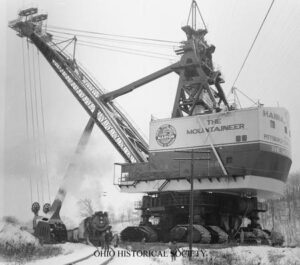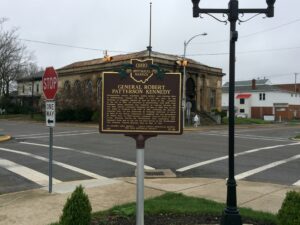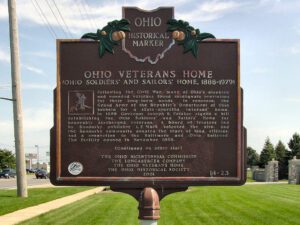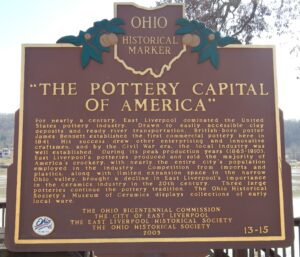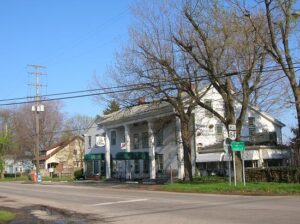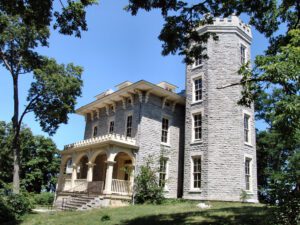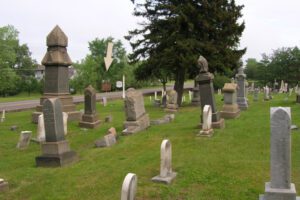, OH
The Marion Steam Shovel Company built the primary tools for America’s civil engineering for more than 100 years. Founded in 1884 by Henry M. Barnhart, George W. King, and Edward Huber, the company’s patent steam shovels helped revolutionize railway and road construction, and were used in the building of the Panama Canal, Hoover Dam, and the Holland Tunnel. “The Shovel” also built ditchers, log loaders, dredges, and draglines, including some of the largest land vehicles ever built. The first electric machine was built in 1915, but it was not until 1946 that the name was changed to Marion Power Shovel. In the mid-twentieth century, “The Shovel” employed 2,500 workers. In the 1960s, the National Aeronautics and Space Administration selected Marion to build the crawlers that transport spacecraft to their launch pads. Hundred-year rival Bucyrus International acquired and closed the company in 1997.
, OH
Distinguished citizen, legislator, public servant, and historian born in Bellefontaine, January 23, 1840. A Civil War hero, he was promoted to brigadier general at only 25 years of age. Admitted to the bar in 1866, he practiced in Bellefontaine until 1878 when President Hayes appointed him Collector of Internal Revenue. He was then elected Lieutenant Governor of Ohio in 1885 then served two terms in Congress from 1887 to 1891. Following the Spanish-American War, he was appointed by President McKinley to serve as head of the Insular Commission to establish the new government of Puerto Rico. In 1903 Kennedy published Historical Review of Logan County. Kennedy started the Bellefontaine Tree Commission. Gen. Kennedy’s home was on this site and later served as the Bellefontaine City Building. General Kennedy died on May 6, 1918.
, OH
Following the Civil War, many of Ohio’s disabled and wounded veterans found inadequate provisions for their long-term needs. In response, the Grand Army of the Republic’s Department of Ohio lobbied for a state-operated veterans’ home. In 1886 Governor Joseph B. Foraker signed a bill establishing the Ohio Soldiers’ and Sailors’ Home for honorably discharged veterans. A board of trustees led by Sandusky publisher I.F. Mack selected the site, and the Sandusky community donated the tract of land, utilities, and a connection to the Baltimore and Ohio Railroad. The facility opened in November 1888. (continued on other side)
, OH
For nearly a century, East Liverpool dominated the United States pottery industry. Drawn to easily accessible clay deposits and ready river transportation, British-born potter James Bennett established the first commercial pottery here in 1841. His success drew other enterprising and innovative craftsmen, and by the Civil War era, the local industry was well established. During its peak production years (1865-1910), East Liverpool’s potteries produced and sold the majority of America’s crockery, with nearly the entire city’s population employed in the industry. Competition from imports and plastics, along with limited expansion space in the narrow Ohio valley, brought a decline in East Liverpool’s importance in the ceramics industry in the 20th century. Three large potteries continue the pottery tradition. The Ohio Historical Society’s Museum of Ceramics displays collections of early local ware.
, OH
First known as the Webster House, later as the New England House, and finally as the Old Tavern, this inn has served travelers on the old Cleveland-Buffalo Road (now State Route 84) since before Ohio became a state. As traffic on the old Indian trail increased and it became a post and stage road, the two original log cabins, built in 1798 and later, were converted to this two-and-a-half story inn between 1815 and 1820. While the tavern was the scene of Civil War-era parties and dances in the second-floor ballroom, local tradition suggests it offered much more clandestine hospitality to escaping slaves as a station on the Underground Railroad. The Unionville Tavern was added to the National Register of Historical Places in 1973.
, OH
Welton Cemetery was known as Roselawn Cemetery until the early 1900s. Early settlers to the Burton area donated the land. Welton Cemetery is the burial place for veterans of the nation’s wars and for several state officials. Judge Peter Hitchcock (1781-1853) served in the War of 1812. From 1810-1852, he was elected to both houses of Ohio’s General Assembly and one term in the U.S. House of Representatives and served on the state’s Supreme Court. He was Chief Justice from 1831-1833 and 1849-1851. In 1850, he was a member of Ohio’s constitutional convention. (Continued on other side)
, OH
Completed in 1865, this home was the vacation retreat of Jay Cooke and his family. Known as the “financier” for the Union states during the Civil War, Cooke organized a program to sell millions of dollars worth of bonds to support the war effort. The house is of a high Victorian Italianate mode with a Gothic style tower topped with crenellations. Distinctive hood moldings outline windows and over-scaled and ornamental brackets support crowning cornices. The house, commonly known as Cooke Castle, hosted many notables of the time, including William T. Sherman, William Howard Taft, Rutherford B. Hayes, Salmon Chase, and John Brown, Jr. Born in Sandusky in 1821, Cooke, an avid fisherman, acquired the island for $3,001 in 1864. University trustee Julius Stone gave the island to The Ohio State University in 1925. The house was placed on the National Register of Historic Landmarks in 1966.
, OH
Settlers from Connecticut were the first to come to Canfield Township in the late 1700s, and they were followed by a second wave of immigrants, Swiss-German pioneers who began arriving from Berks and Leigh counties in Pennsylvania in 1804. In 1810, these “Pennsylvania Dutch” established The Zion Lutheran and Reformed Church and built a log church and cemetery on this site. The church was destroyed by fire in 1845 and a new church served the congregation well until it too was destroyed by fire in 1894. The cemetery, known as The Old Dutch and German Burying Ground, German Cemetery, and Lynn Cemetery and now Old North Cemetery, is all that remains. Among the dozens of old stone markers, some in German, are markers for veterans of the American Revolution, War of 1812, Civil War, and other wars.


